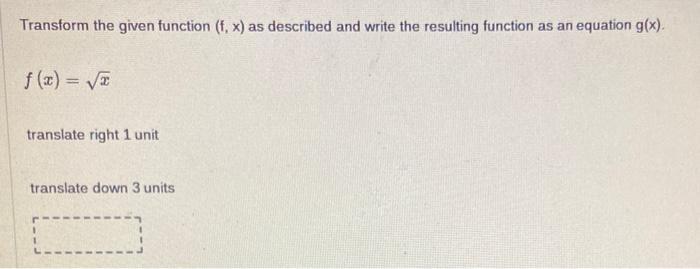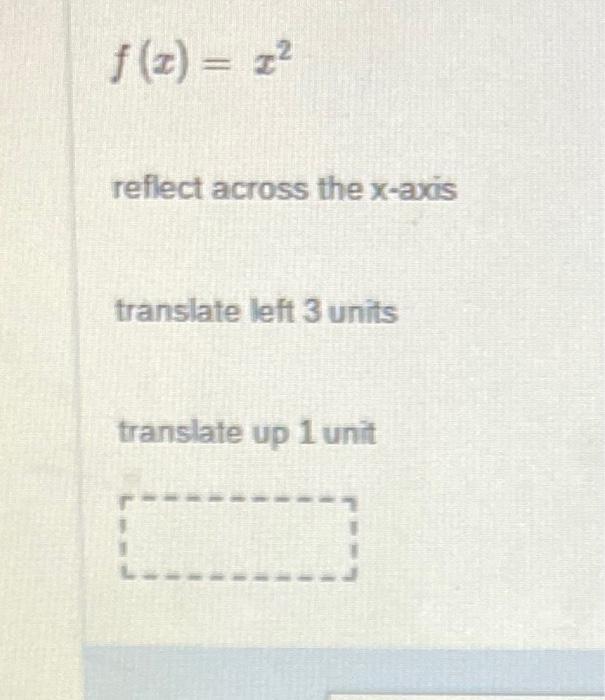Transform the given function (f,x) as described and write the resulting function as an equation g(x)....
Fantastic news! We've Found the answer you've been seeking!
Question:



Transcribed Image Text:
Transform the given function (f,x) as described and write the resulting function as an equation g(x). f(x)=√x translate right 1 unit translate down 3 units 1 ƒ(z) = z² reflect across the x-axis translate left 3 units translate up 1 unit :: g(z) = √2+1+3 #g(z)=√2-3+1 #g(x)=-(-3)² +1 #g(z)=(-(2-3))² +2 g (2)=√2-1-3 g(z)=√√2+3+1 g(a). -(z+3)²+1 g(z)-(-(2-2))² +3 Transform the given function (f,x) as described and write the resulting function as an equation g(x). f(x)=√x translate right 1 unit translate down 3 units 1 ƒ(z) = z² reflect across the x-axis translate left 3 units translate up 1 unit :: g(z) = √2+1+3 #g(z)=√2-3+1 #g(x)=-(-3)² +1 #g(z)=(-(2-3))² +2 g (2)=√2-1-3 g(z)=√√2+3+1 g(a). -(z+3)²+1 g(z)-(-(2-2))² +3
Expert Answer:
Answer rating: 100% (QA)
1 Given that fx x To shift the graph right 1 unitsubtract 1 in... View the full answer

Related Book For 

Discovering Advanced Algebra An Investigative Approach
ISBN: 978-1559539845
1st edition
Authors: Jerald Murdock, Ellen Kamischke, Eric Kamischke
Posted Date:
Students also viewed these accounting questions
-
Complete the following steps for the given function f and interval. a. For the given value of n, use sigma notation to write the left, right, and midpoint Riemann sums. Then evaluate each sum using a...
-
Complete the following steps for the given function f and interval. a. For the given value of n, use sigma notation to write the left, right, and midpoint Riemann sums. Then evaluate each sum using a...
-
Complete the following steps for the given function f and interval. a. For the given value of n, use sigma notation to write the left, right, and midpoint Riemann sums. Then evaluate each sum using a...
-
Make a comparison of the following insurance coverage premium bids and determine from a costing standpoint, which offer is better. Show your calculations: Assume that you, as a risk manager would...
-
Explain the following statement: One contribution of the independent auditor is to lend credibility to financial statements.
-
Maria Juarez is a licensed dentist. During the first month of the operation of her business, the following events and transactions occurred. April 1 Invested $40,000 cash. 1 Hired a...
-
Renkas Heaters selected data for October 2017 are presented here (in millions): Calculate the following costs: 1. Direct materials inventory 10/31/2017 2. Fixed manufacturing overhead costs for...
-
On January 1, 2014, Prasad Corporation had the following stockholders equity accounts. Common Stock ($25 par value, 48,000 shares issued and outstanding) ..................$1,200,000 Paid-in Capital...
-
A manager could increase his or her accounting income-based bonus by Multiple choice question. delaying discretionary expenses. delaying shipments of its products. disclosing additional contingent...
-
Amazon Wood Products, Inc. is a manufacturer of fine quality tables, chairs, and desks. The following information relates to expected production, sales, and other costs for next year (ended December...
-
What causes changes in the business cycle, shifts in aggregate demand or aggregate supply? Is one more important than the other?
-
Figure below shows a schematic phase diagram of Al - Cu alloy with Al melting point of 660 C, eutectic temperature 548 C, maximum solubility of Cu in Al = 5.65 wt%, and eutectic composition Xcu 33...
-
Tesla likes to know how many test drives its Los Angeles dealerships provide on any given business day. Tesla knows that test drives average 24 per dealership per day with a standard deviation of 5....
-
Scope creep is identified often as the leading cause of project failure. It would seem that ABC Bank has fallen victim to its negative effects. Analyse what are the major sources of scope creep in...
-
The US 1 year spot rate is 2.16% and the Mexican 1 year spot rate is 4.09%. A US investor purchases a Mexican corporate bond with an expected 1 year return of 9.67%, as measured in Mexican peso. The...
-
How will the following goals improve processes and lower costs for the Piney Woods emergency department? How will the progress and achievement of each stretch goal will be measured? 1. Achieving a...
-
Suppose you own a company which you expect will earn the following set of state-contingent profits, prior to compensating your company's manager: Pa Low Effort, High Effort Average Economy Profit...
-
The National Collegiate Athletic Association (NCAA) and the National Federation of State High School Associations (NFHS) set a new standard for non-wood baseball bats. Their goal was to ensure that...
-
Consider this sequence. -6, -4, 3, 15, 32( ( ( ( a. Find the nth term using finite differences. Assume -6 is u1. b. Find u20.
-
Find a second value of that gives the same trigonometric value as the angle given. Use domain 0 360. a. sin 23 = sin b. sin 216 = sin c. cos 342 = cos d. cos 246 = cos
-
The value of a building depreciates at a rate of 6% per year. When new, the building is worth $36,500. a. How much is the building worth after 5 years 3 months? b. To the nearest month, when will the...
-
What were Aristotles two main classifications of motion?
-
One kg weighs 10 N on Earth. Would it weigh more or less on the Moon?
-
Which has the greater density1 kg of water or 10 kg of water?

Study smarter with the SolutionInn App


